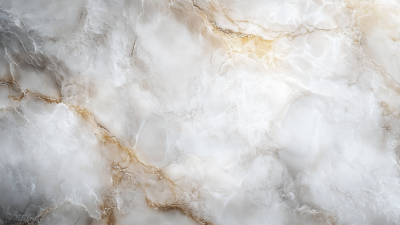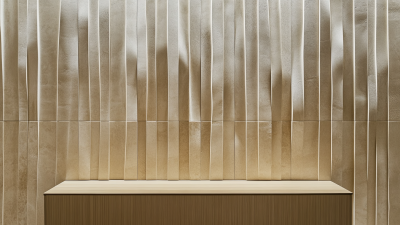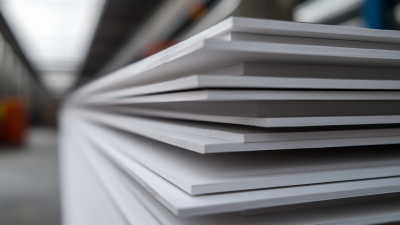
In the ever-evolving world of modern construction and renovation, the significance of materials and design choices cannot be overstated. Among the innovative options available, UPVC wall cladding has emerged as a leading choice for both new builds and refurbishment projects. This versatile material not only offers aesthetic appeal but also provides exceptional durability and weather resistance, making it an ideal solution for various architectural needs. As we move towards 2025, it is essential to explore the top trends in UPVC wall cladding that are set to shape the future of construction and renovation.

From sleek, contemporary designs to eco-friendly options that cater to the increasing demand for sustainability, UPVC wall cladding is adapting to meet the diverse preferences of homeowners and builders alike. The integration of technological advancements, such as improved manufacturing processes and enhanced insulation properties, is paving the way for a new era in wall cladding solutions. In this article, we will delve into the most exciting developments and trends that highlight the potential of UPVC wall cladding, underscoring its role as a cornerstone in modern architecture.
In 2025, the landscape of UPVC wall cladding will be transformed by innovative textures and finishes that cater to the evolving demands of modern construction and renovation. Industry reports project that the demand for UPVC cladding will grow by 8% annually, driven by its low maintenance, durability, and aesthetic flexibility. Architects and builders are increasingly opting for cladding that not only protects but also enhances the visual appeal of structures. Unique textures, such as wood grain and stone finishes, are expected to dominate the market, creating striking visual contrasts and allowing for customization that meets unique architectural styles.

One tip for potential buyers is to consider the environmental impact of the materials used. Look for UPVC wall cladding products that are manufactured using eco-friendly processes and recycled materials. This choice not only contributes to sustainability but may also qualify for green building certifications, which can enhance the property's value.
Additionally, when selecting UPVC finishes, it's essential to examine the color retention and UV resistance of the products. High-quality finishes can resist fading, ensuring that buildings maintain their appearance over time without the hassle of frequent repainting. By focusing on these innovative aspects of UPVC wall cladding, builders and homeowners can achieve aesthetic appeal while ensuring long-term performance and sustainability.
The construction industry is witnessing a significant shift towards sustainable practices, particularly in the use of eco-friendly materials such as UPVC (Unplasticized Polyvinyl Chloride) wall cladding. According to a report by MarketsandMarkets, the global UPVC cladding market is expected to reach USD 6.2 billion by 2025, with a compound annual growth rate (CAGR) of 5.4%. This trend highlights the increasing demand for sustainable building solutions that not only reduce environmental impact but also enhance the aesthetic appeal of modern architecture.
The key characteristics of UPVC make it an ideal choice for eco-conscious construction. It is 100% recyclable and has a low carbon footprint, significantly reducing waste generation compared to traditional materials. Additionally, UPVC cladding offers excellent insulation properties, which can lead to energy savings of up to 30% according to the Building Research Establishment (BRE). This dual benefit of functionality and sustainability positions UPVC as a leading material choice for both new builds and renovation projects, aligning with the broader industry goals for greener building practices.
In 2025, the landscape of UPVC wall cladding is set to be profoundly influenced by evolving color trends that speak to modern aesthetics and functionality. As homeowners and designers increasingly prioritize sustainability and innovation, the palette selected for UPVC cladding will reflect these values. Shades of earthy tones such as terracotta, soft greens, and muted blues will gain popularity, embracing a connection to nature while fostering a calming environment. The use of these colors not only contributes to an inviting exterior but also aligns with the growing trend of biophilic design.
In contrast, bold and vibrant colors will make a statement in urban settings, with deep jewel tones like emerald, sapphire, and rich burgundy taking the spotlight. These vivid hues are perfect for creating striking visual contrasts against neutral backgrounds, offering a modern twist on traditional cladding designs. Furthermore, incorporating sophisticated finishes such as matte or metallic sheens can elevate the overall aesthetic, inviting curiosity and engagement. The interplay of color and texture in UPVC wall cladding will undoubtedly enhance both residential and commercial properties, making 2025 a hallmark year for creative and expressive exterior designs.
Smart technology is revolutionizing the way we approach UPVC wall cladding in modern construction and renovation. As homeowners and builders prioritize energy efficiency and sustainability, incorporating advanced technology into UPVC cladding solutions has become a focal point.
 Intelligent sensors embedded within the cladding can monitor temperature, humidity, and overall structural health, allowing for proactive maintenance and reducing the risk of damage over time. This integration not only enhances the durability of the cladding but also optimizes energy consumption within the building.
Intelligent sensors embedded within the cladding can monitor temperature, humidity, and overall structural health, allowing for proactive maintenance and reducing the risk of damage over time. This integration not only enhances the durability of the cladding but also optimizes energy consumption within the building.
Furthermore, the rise of automation in building management systems facilitates real-time communication between UPVC cladding and smart home devices. For instance, climate control systems can be synchronized with the environmental data gathered by the cladding, ensuring that interior conditions remain comfortable while minimizing energy use. Additionally, advanced coatings and finishes can be paired with these smart solutions to provide self-cleaning capabilities, drastically reducing maintenance efforts and costs. This seamless blend of technology and materials reflects a significant shift towards smarter, more efficient building practices that cater to the needs of modern living.
UPVC wall cladding has emerged as a game-changer in modern construction and renovation, primarily due to its cost-effective advantages. One of the most compelling benefits of UPVC is its low maintenance requirement. Unlike traditional materials that may require frequent painting, sealing, or repairs, UPVC maintains its appearance and functionality over time, significantly reducing long-term upkeep costs. This reliability allows developers and homeowners to allocate their budgets more efficiently, focusing on other critical elements of their projects.
In addition to maintenance savings, UPVC wall cladding offers excellent insulation properties, contributing to energy efficiency. By providing effective thermal resistance, UPVC helps in reducing heating and cooling costs, further enhancing its value as a construction material. Furthermore, the lightweight nature of UPVC makes it easier and cheaper to install compared to heavier alternatives, minimizing labor costs and construction time. As a result, the integration of UPVC wall cladding in modern building practices not only supports aesthetic and functional goals but also aligns with a financially prudent approach to building and renovation projects.
| Trend | Description | Cost Advantage ($/sq ft) | Durability (Years) | Maintenance Level |
|---|---|---|---|---|
| Sustainable Materials | Incorporating recycled materials in UPVC for eco-friendly options. | $4.00 | 30+ | Low |
| Color and Texture Variety | Expanding color palettes and textured finishes for aesthetic appeal. | $3.50 | 25+ | Moderate |
| Energy Efficiency | Improved insulation properties to reduce energy costs. | $3.80 | 50+ | Low |
| Easy Installation | Lightweight and user-friendly designs that speed up the installation process. | $4.20 | 20+ | Very Low |
| Resistance to Weathering | UPVC's capability to withstand harsh weather conditions without deteriorating. | $3.90 | 30+ | Low |






